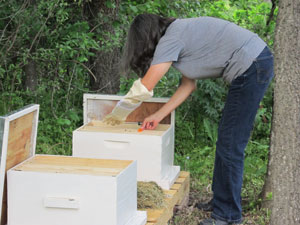This week I'll tell you how I got the bees out of the shipping box, and into the hive. This process is called "hiving" the bees.
Hiving Bees in 4 Easy Steps (actually, I found it rather challenging, but it looks easy!)
Step 1: There's a metal syrup can blocking the hole of the shipping box to keep the bees from escaping. Remove the can and reach into the box (yes, into a box of buzzing, possibly stinging bees) to get the queen cage out. Quickly replace the can or the bees will escape before you want them to.
Step 2: Remove the little cork at the end of the queen cage. On the other end of the cage is a marshmallow stopper that you leave in place. Then you put the queen cage into the hive body between two of the frames.
As I mentioned last week, this stage is critical. At this point the queen is a stranger to the bees in the shipping box, and if you put them all together in the hive, they will kill the queen.
Step 3: Remove the syrup can and shake the bees out of the shipping box and over the frames holding the queen cage.
In two or three days you open the hive and remove the queen cage. If all has gone well it will be empty because the bees will have eaten through the marshmallow stopper and released the queen. Since the bees have had a few days to get used to her smell while they were eating the marshmallow, they will accept her.
If something goes wrong, such as they eat through the marshmallow to quickly, or don't like the queen's smell, they will kill her. In that case you'd have to quickly get a replacement queen, since a hive without a queen will die in a few weeks.
Hive Maintenance
Once you've done the hiving, bees require little maintenance until it's time to harvest the honey (usually in August or September in our area). Each month I check the hive to ensure the queen is still there and that the bees are filling the frames with brood and honey. So far, so good!




No comments:
Post a Comment